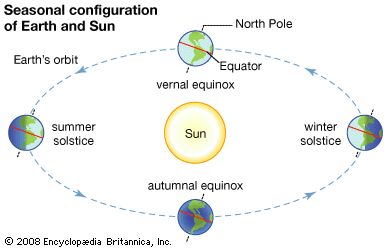

The second phase is nautical twilight, between 6 and 12 degrees below the horizon. The first one is civil twilight, which begins once the Sun has disappeared below the horizon, and continues until it descends to 6 degrees below the horizon. Sunset is distinct from twilight, which is divided into three stages. Near the horizon, atmospheric refraction causes sunlight rays to be distorted to such an extent that geometrically the solar disk is already about one diameter below the horizon when a sunset is observed. The time of actual sunset is defined in astronomy as two minutes before the upper limb of the Sun disappears below the horizon. As viewed from the Northern Hemisphere, the Sun sets to the northwest (or not at all) in the spring and summer, and to the southwest in the autumn and winter these seasons are reversed for the Southern Hemisphere. The equinox Sun sets due west at the moment of both the spring and autumn equinoxes. As viewed from everywhere on Earth, it is a phenomenon that happens approximately once every 24 hours except in areas close to the poles.

Sunset (or sundown) is the disappearance of the Sun below the horizon of the Earth (or any other astronomical object in the Solar System) due to its rotation. Actual Sunset: Two minutes before the Sun disappears below the horizon. ε, obliquity of the ecliptic (about 23.Not to be confused with Dusk.There are also subdivisions into "mean of date" coordinates, which average out or ignore nutation, and "true of date," which include nutation.

Popular choices of pole and equator are the older B1950 and the modern J2000 systems, but a pole and equator "of date" can also be used, meaning one appropriate to the date under consideration, such as when a measurement of the position of a planet or spacecraft is made. Celestial objects are found by adjusting the telescope's or other instrument's scales so that they match the equatorial coordinates of the selected object to observe.
#HORIZON DEFINITION ASTRONOMY PROFESSIONAL#
The equatorial system is the normal coordinate system for most professional and many amateur astronomers having an equatorial mount that follows the movement of the sky during the night. The equatorial describes the sky as seen from the Solar System, and modern star maps almost exclusively use equatorial coordinates. The coordinates are based on the location of stars relative to Earth's equator if it were projected out to an infinite distance. The equatorial coordinate system is centered at Earth's center, but fixed relative to the celestial poles and the March equinox. Main article: Equatorial coordinate system Intersection of supergalactic plane and galactic plane Horizontal (also called alt- az or el-az)Ĭenter of the Earth (geocentric), or Sun (heliocentric) The origin is the zero distance point, the "center of the celestial sphere", although the definition of celestial sphere is ambiguous about the definition of its center point. The primary direction is the starting point of the longitudinal coordinates. The poles are located at ☙0° from the fundamental plane. The fundamental plane divides the celestial sphere into two equal hemispheres and defines the baseline for the latitudinal coordinates, similar to the equator in the geographic coordinate system. The following table lists the common coordinate systems in use by the astronomical community. Each coordinate system is named after its choice of fundamental plane. Rectangular coordinates, in appropriate units, have the same fundamental ( x, y) plane and primary ( x-axis) direction, such as an axis of rotation. These differ in their choice of fundamental plane, which divides the celestial sphere into two equal hemispheres along a great circle. Spherical coordinates, projected on the celestial sphere, are analogous to the geographic coordinate system used on the surface of Earth. Coordinate systems in astronomy can specify an object's position in three-dimensional space or plot merely its direction on a celestial sphere, if the object's distance is unknown or trivial. the true horizon and north to an observer on Earth's surface). The origin of coordinates (the "center of the sphere") is ambiguous see celestial sphere for more information.Īstronomical (or celestial) coordinate systems are organized arrangements for specifying positions of satellites, planets, stars, galaxies, and other celestial objects relative to physical reference points available to a situated observer (e.g. Ecliptic and equatorial coordinates share the March equinox as the primary direction, and galactic coordinates are referred to the galactic center. A star's galactic, ecliptic, and equatorial coordinates, as projected on the celestial sphere.


 0 kommentar(er)
0 kommentar(er)
